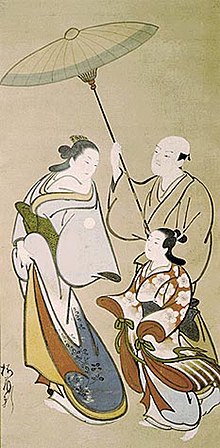
Baiōken Eishun (Japanese: 梅翁軒永春; active c. 1710–1755) was a Japanese painter and print artist of the Kaigetsudō school of ukiyo-e art. He is also alternatively known as Hasegawa Eishun 長谷川永春, Baiōken Nagaharu, Takeda Harunobu and a number of other art-names. He produced both hanging scroll full-color paintings typical of the Kaigetsudō style and mode, and a number of designs for illustrations for woodblock printed books.
Richard Lane describes Eishun's work as very similar to that of Matsuno Chikanobu, though the courtesans in his bijinga (paintings of beauties) are somewhat taller, slimmer, and more serious-looking. Eishun, along with Chikanobu, represents something of a revival of the Kaigetsudō school which fell into decline in the preceding decades following the exile of its founder, Kaigetsudō Ando, in 1714.
Notes
- Morse, Anne Nishimura et al. Drama and Desire: Japanese Paintings from the Floating World 1690-1850. Boston: Museum of Fine Arts, 2007. p80.
References
- Lane, Richard. (1978). Images from the Floating World, The Japanese Print. Oxford: Oxford University Press. ISBN 9780192114471; OCLC 5246796
- Nussbaum, Louis Frédéric and Käthe Roth. (2005). "Baiōken Nagaharu," Japan Encyclopedia. Cambridge: Harvard University Press. ISBN 978-0-674-01753-5; OCLC 48943301
This article about a Japanese painter is a stub. You can help Misplaced Pages by expanding it. |
